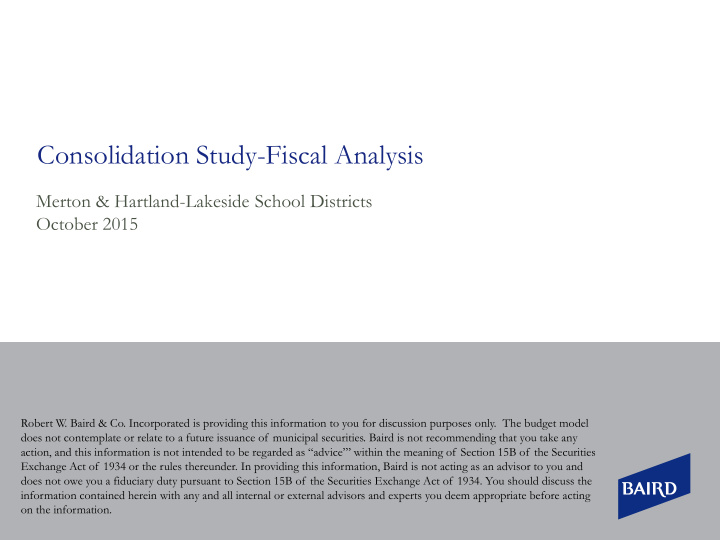



Consolidation Study-Fiscal Analysis Merton & Hartland-Lakeside School Districts October 2015 Robert W. Baird & Co. Incorporated is providing this information to you for discussion purposes only. The budget model does not contemplate or relate to a future issuance of municipal securities. Baird is not recommending that you take any action, and this information is not intended to be regarded as “advice”’ within the meaning of Section 15B of the Securities Exchange Act of 1934 or the rules thereunder. In providing this information, Baird is not acting as an advisor to you and does not owe you a fiduciary duty pursuant to Section 15B of the Securities Exchange Act of 1934. You should discuss the information contained herein with any and all internal or external advisors and experts you deem appropriate before acting on the information. Page 1
Presenter Robert W. Baird & Co. School Business Solutions Debby Schufletowski Sr. Vice President • 715-552-3567 (office) • 715-214-5149 (cell) • dschufletowski@rwbaird.com Page 2 Page 2
Background of Consolidation Studies • Consolidation studies recently more prevalent • Structural budget deficits • State budget incentives • Consolidation Study Financial Analysis • How do individual district projections compare to the consolidated district projections? • State formulas • Local trends, etc. • What consolidation aid may we be eligible for? • What efficiencies may result? • What is the taxpayer impact? • Consolidation Studies identify trends – variables will change between the study and potential consolidation which will affect actual figures. • General mill rate trend: consolidated projections fall between individual district projections Page 3
School Board Financial Decision-making Budget Levy/Mill Rate Educational Opportunities Page 4
Revenue Limit Calculation Hartland-Lakeside and Merton Operational Revenue • Limits and calculates Revenue Limit Revenue Other Revenue operational revenue • Comprised of State aid and the local tax 10% levy • Generally comprises 85% - 95% of school districts’ operational (Fund 10) revenue • Consolidation aid is outside of the revenue limit 90% Page 5 Page 5
Budget Overview • 90% of the district’s revenue is comprised of revenue Resident limit dollars Membership (FTE) • $0 increases in revenue limit authority for 2015-16 and 2016-17; future budgets unknown • Both districts experiencing and forecasting declining enrollment Per-pupil amount • Why is this important? – 90% of the district’s revenue authority is driven by stable to declining variables Exemptions • Does this change with consolidation? – No. But size and efficiencies may provide longer-term Total Revenue stability. Limit Authority Page 6 Page 6
Resident Membership & Revenue Limit Per-Pupil Resident Membership Revenue Limit Per-Member projected FTE sample $ 2,000 $9,800 1,800 $9,700 1,600 $9,600 Merton 1,400 $9,500 1,200 $9,400 1,000 $9,300 $9,200 800 Hartland- $9,100 600 Lakeside $9,000 400 200 0 Individual Districts Consolidated Scenario • Our state formulas are driven by resident • The maximum revenue per member for the membership . Therefore, for most state formulas, consolidated district is recalculated based on the the consolidated district membership is the sum of individual districts’ data the year prior to the individual districts’ counts. consolidation. Page 7
Budget Summary – Individual Districts Page 8
Budget Summary – Sample Consolidated District • The consolidated model includes $500,000 of anticipated administrative cost savings. • According to current state statutes, consolidation aid is available for five years and is outside of the revenue limit. • New in the 2015-17 biennial budget is an ongoing revenue limit exemption starting in year six of consolidation. This analysis estimates the ongoing exemption amount at approximately $2.5M-$3.0M Page 9
Potential Taxpayer Impact – Revenue Limit Revenue Limit State Aid and Local Levy State Aid Local Levy Hartland-Lakeside 20% 80% Merton 44% 56% Consolidated Scenario 30% 70% Page 10
Potential Taxpayer Impact (cont.) Mill Rate Projections sample consolidation scenario $6.60 $6.40 $6.20 $6.00 $5.80 $5.60 $5.40 2017-18 2018-19 2019-20 2020-21 Hartland-Lakeside Merton Consolidated Scenario • This output reflects mill rate trends. Changes in local and state variables will affect these trends. • As in most studies, the initial mill rate of the consolidated district is projected to fall between the individual districts’ mill rate projections. Page 11
In Summary – Projected Impact Home Hartland- Value Scenario Lakeside Merton • In the first year, Not the mill rate is $650 $616 projected to fall consolidated $100,000 between the mill rates of the Consolidated $627 individual districts. • An estimate of Not 2017-18 mill rate $1,625 $1,540 impact is shown. consolidated $250,000 Consolidated $1,568 Not $3,250 $3,080 consolidated $500,000 Consolidated $3,135 Page 12 Page 12
Questions? Page 13
Recommend
More recommend